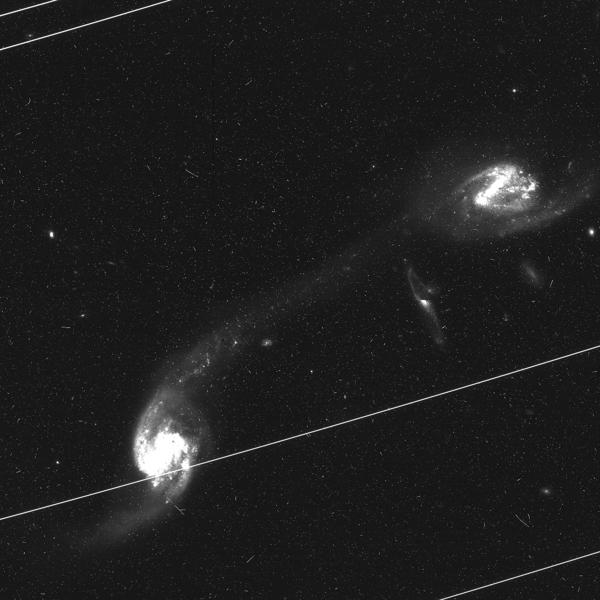Leicester undergraduate Megan Perks is part of an ESA internship group researching the impact of mega-constellation satellites on space-based telescopes. Her team are looking for volunteers to engage with their citizen science project to identify satellite trails in Hubble images.
When we think of the biggest threats to science today we often think of rouge atomic bombs, devastating advancements to biowarfare, AI that gain consciousness and deem the human race disposable… but very rarely do we consider that satellites, the very objects that gift us GPS, Earth observations and even global connectivity could be the most significant threat our understanding of the Universe itself.

Satellites provide many benefits and services that the world today could not live without – navigation, telephone services, weather predictions, climate and environmental monitoring, business and finance services, space science etc.. The latest (and perhaps greatest) service of all is the possibility of a high-speed global internet system aiming to provide connectivity to even the most remote places on the globe. But what would the cost of such a system be, and who is really paying? Companies such as Starlink, OneWeb and Amazon Kuiper (to name only a few) deem the financial cost of such systems justifiable, but the rest of the world is left with a much bigger price to pay, and it’s more than just the sacrifice of our night sky.

https://www.statista.com/statistics/897719/number-of-active-satellites-by-year/
Satellites are currently being launched into orbit in mega-constellations at rates that the global scientific community are completely unprepared for. The number of active satellites in orbit has sky-rocketed in the past few years with the number more than doubling between 2017 and 2021. Only now are scientists beginning to research and quantify the effects that these mega-constellations of satellites will have on various types of astronomy, with long exposure optical astronomy being the most at risk from these LEO constellations.
Some systems will be affected more than others – work has been done to quantify the impact on some ground-based observatories such as the Vera C. Rubin Observatory (which expects a huge 30-40% of its ultra-wide imaging exposures on the very large telescope to be compromised during the first and last hours of summer nights) but studies on the effect of the satellites on LEO telescopes such as Hubble Space Telescope, CHEOPS, NEOWISE etc. have only just begun. These studies are essential for understanding not only the current impact on scientific data but also for modelling the future impact on scientific observations. Current plans for future satellite mega-constellations will see approximately 136,000 new communications satellites being launched in the coming decades – a staggering amount that no current mitigation plan can protect against.
Some mitigation techniques include the algorithmic reduction of satellite trails in images, but this isn’t 100% effective and cannot be applied to all kinds of observations, especially those observing short duration events that require a high level of sensitivity. Some of the main areas of scientific observations that may be severely impacted by satellite trail contamination include – rare transient events, deep wide extragalactic imaging, near-Earth object detection and monitoring, exo-planet transits in wide-field surveys, discovery of new phenomena and many more. Some short duration, small field observations may be able to schedule observations to avoid satellite crossings, but this would require a continuous up-to-date database of the high-precision orbital elements of all objects in orbit and will become increasingly difficult as the number of satellites increases. This is also not applicable for long-exposures or wide-filed imagery as the probability of a satellite crossing the field of view is substantially higher and will likely be impossible to avoid in the future in many cases.
Not only do these mega-constellations affect the contamination of scientific observations, but they also increase the urgency for updated space debris and collision monitoring and mitigation techniques. The very nature of the unpredictable space environment makes accurate satellite tracking a phenomenally difficult task, and the lack of free communication between satellite companies about the location of their satellites creates an increasingly chaotic environment with an ever increasingly high collision risk.
These satellites will provide incredible services for a global community of people, but studies such as those being done by ESA to quantify the future impact on observations are imperative for preparing the scientific community for the problems to come.
To get involved with the ESA citizen science project classifying satellite trails in Hubble images yourself, go to https://www.zooniverse.org/projects/sandorkruk/hubble-asteroid-hunter/talk/2468/2083595 .
Relevant papers:
- Haniaut 2020 “Impact of satellite constellations on astronomical observations with ESO telescopes in the visible and infrared domains”
- McDowell 2020 “The Low Earth Orbit Satellite Population and Impacts of the SpaceX Starlink Constellation”

 Subscribe to Physics & Astronomy's posts
Subscribe to Physics & Astronomy's posts
Recent Comments